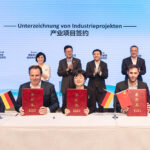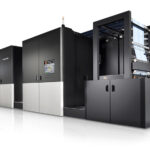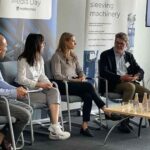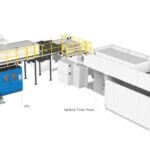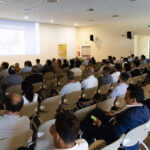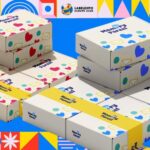Tech:Art (graphics and packaging) shows how a creative enterprise can take advantage of the prerogatives of the most advanced digital technology to invent new products and services, bringing to light the potential of an extraordinary machine pool based on HP Indigo systems and other gems.
 The name “Tech:Art” expresses the two faces of a concern which, in order to demonstrate its expertise in the field of graphics and converting (from ideation to production: design, style, digital printing, packaging finishing and POP material), opened its doors to customers and opinion leaders last 9 to 11 September. The event, organized together with a group of suppliers of excellence (HP, Esko B+B, Petratto, Duplo Neopost, Fedrigoni, Agfa MGI and Luxoro), showcased both the creativity of a dynamic and proactive staff and the technology of an up to date machine pool based on digital technology, and, here too, how creativity breaks the usual barriers, turning the encounter into a journey along 5 production processes and as many print types: flyers, brochures, packaging, window displays and window signage. The art appeared in the form of music, with the help of a live pianist, and painting, with Massimo Polello’s large painting “in tiles”, which then became a series of souvenirs for participants.
The name “Tech:Art” expresses the two faces of a concern which, in order to demonstrate its expertise in the field of graphics and converting (from ideation to production: design, style, digital printing, packaging finishing and POP material), opened its doors to customers and opinion leaders last 9 to 11 September. The event, organized together with a group of suppliers of excellence (HP, Esko B+B, Petratto, Duplo Neopost, Fedrigoni, Agfa MGI and Luxoro), showcased both the creativity of a dynamic and proactive staff and the technology of an up to date machine pool based on digital technology, and, here too, how creativity breaks the usual barriers, turning the encounter into a journey along 5 production processes and as many print types: flyers, brochures, packaging, window displays and window signage. The art appeared in the form of music, with the help of a live pianist, and painting, with Massimo Polello’s large painting “in tiles”, which then became a series of souvenirs for participants.
Art played a central and founding role at the event: «Our intention – explained GM Davide Salvo – was to show the weight of the Art-istic half of our name. While, indeed, the quality of our work is certainly a result of the advanced technology we employ, imagination and creativity represent the spark that enables us to conceive new solutions and innovative applications».
Dreams in the metro
“Dreams Come True – dal Sogno alla Realtà” is the title of the event which brought together over 100 visitors, including graphics concerns, brand owners and creative firms. It was conceived as a metropolitan train ride, with a station dedicated to each of five products, and for each one a speaker showed its conception and execution: a journey within a journey designed to «discover machinery, innovations, processes, but especially to show in detail the potential of each phase of the process in such a way that you can apply all these mechanisms in your daily work, with the help of experts from the brands themselves, ready to answer any question», explained Salvo to visitors. He concluded with a final “revelation”: «At the end of each tour you will see a finished product that at the beginning had been only a dream, and you’ll return home knowing that dreams can become reality».

Stations and destinations
Digital printing, cutting and milling, die-cutting, special applications and effects, application of foils, varnishes and reliefs, binding and related processes. These are the “creative technologies” offered by Tech:Art, illustrated in five stations and eight stops, introduced with a speech by Vincenzo Cirimele, who shared a few reflections on market orientations and repercussions on communication supports. It was a wonderful gift: Cirimele’s experience is made clear by the roles he has served: a member of the board of Dscoop, the HP digital printer community; CEO of a large Italian web-to-print operator; Managing Director of a historical traditional printer…

Digital Printing Square. The brand new HP Scitex FB 11000 (1) replaces the previous FB 10000, opening new markets. Its main strength: HP Scitex HDR250 multipurpose inks, which guarantee perfect adhesion and high resistance, allowing maximum versatility in application, even at high speeds. This solution is suitable for printing posters, plastic materials and rigid supports for converting and making glossy/matt finish and features a new sheet feed system that optimizes corrugated cardboard printing.
Matching Avenue. The cutting/milling digital plotter Kongsberg C64 in 3.20 x 3.20 m format (2) cuts thin materials like paper and card, plastic and corrugated supports, PVC and honeycomb, but also rigid ones (window displays), Plexiglas, mirrored polycarbonate and Forex. Performance: perfect register between print and cutting; quick changeover from one material to another simply by replacing the point; 45 degree cutting for rigid materials that cannot be die-cut.
Cutting Avenue. The Petratto PDF74 die-cutter (3), for digital printing and short runs, performs cutting, creasing, perforation and semi-cutting, as well as dry relief and hot foil. It works in tabletop format with traditional (and economical) dies with wood support; front end sheet pick & place; sheet placer with automatic squaring. With this system, Tech:Art can now work with 53 x 74 cm formats.
Also from Petratto, the Piedmontese converter uses the Mini Metro 78 folding hotmelt gluing system, which features extreme flexibility and modularity thanks to interchangeable tools and quick setup. Web between 78 and 105 cm.

Gutenberg Square. At this stop, experts illustrated the characteristics and potential of Fedrigoni’s certified Indigo papers (4), various models of the HP Indigo digital printer, the Digital Line r DM Luxoro and the Agfa varnishing system.
A few remarks explain the reasons for this setup. Thanks to its 75 cm format, the HP Indigo 10000 (5) is well-adapted to any job and features high stacking and an improved picking system. Tech:Art uses it for packaging, boxes, small displays, trays and stapled booklets, using a wide range of materials (paper, adhesive vinyl, glossy and non-glossy supports, recycled and uncoated papers) and weights between 65 and 450 g/m2.
A high grade of automation enables performing controls on every crucial aspect of the job (supports, inks, etc.) and indicating necessary corrections.
Tech:Art has installed other HP machines in Gutenberg Square as well: the HP Indigo 5600 with One Shot Colour printing («we use it for specialty or special effects jobs, for printing on plastic, flexible or special materials, using white and matt inks. Here we can follow our imagination and play in order to meet the non-standard demands of our customers» Salvo declares) and the HP Indigo 7600 for small format sheets, characterized by high productivity and reliability.

This is also where the site of the first DM Liner by Kurz sold in Italy (6). This system combines foil transfer and digital printing using original technology, decorating limited runs on a wide range of substrates and jobs: labels, flyers and brochures, magazines and packaging, test prints and mockups… This machine enables achieving metallized effects with the addition of variable data and, with the help of a dedicated software, pay-per-print billing, which automatically records prints used and manages stocks via PC. It represents an eclectic tool for creative jobs to which Tech:Art could not resist the temptation.
Finally, well worth mention is the AGFA JetVarnish 3D (7). This inkjet UV varnish system is suitable for decorating offset and digital prints up to 52×105 cm and can perform UV spot varnishing at high speeds (up to 3100 sheets/h) with new three-dimensional effects. It also works at very low thicknesses (3 microns), on multiple levels, even on short runs, with maximum gloss and quality guaranteed by a camera that reads the marks sheet by sheet, compensating for any deformations.
Crease Avenue. And this brings us to the last top, a station dedicated to cutting, folding and creasing, which Tech:Art performs using machinery by Duplo (represented in Italy by Neopost) and Petratto Batfold. Pictured, the Duplo DC646Pro (8), the latest addition to the range of systems for multiple sheet finish in a single step, combining all processes in a single machine (slitter/cutter/creaser).

A journey of growth (appetite comes with eating)
The path along another journey, that of Tech:Art, from its foundation to the present day, shows the strength of the intersection between technological scouting – in search of machinery capable of creating both products already known and those only dreamed of – and careful monitoring of the orientation and needs of the market. All this with digital technology as compass, and HP Indigo solutions breaking new paths to follow.
– Tech:art is born in 2001 as a specialist in mockups and prototypes, with 10 employees and basic equipment;
– in 2002 the first digital cutting plotter is acquired to make paper prototypes;
– in 2004, the necessity to create POP material, not just paper ones, leads to the acquisition of the concern’s first Biesse milling system;
– 2006 represents a watershed moment: Tech:art adopts its first HP Indigo series 1, which starts full-fledged industrial production. From then on, the company accelerates the rhythm of its investments;
– in 2007, the concern undertakes wide format with its first solvent plotter and tabletop UV plotter;
– in 2009, the first HP Indigo S2000 and the second HP Indigo series 2; the UV plotter is replaced to enhance quality and productivity;
– also in 2009, the first foray into 3D printing, ahead of schedule;
– and since “appetite comes with eating”, in 2011, the third HP Indigo series 3 is added, reaching previously unthinkable levels of industrial productivity for small formats. Consequently, the finishing division is also developed, internalizing and optimizing binding, cutting, creasing and folding;
– in 2013, another turning point in wide format, thanks to the acquisition of an HP Scitex FB7600. At the same time, in order to offer customers increasingly innovative finish solutions, the concern opted for a JetVarnish 3D;
– in 2014, another jump in quality: a new headquarters, and a new HP Indigo 10000, replacing the HP Scitex FB10000 with the FB7600, upgrading the cutting division with the addition of a Kongsberg C64 and a Zund S3;
– and 2015? The year of innovation. Acquisition of a Petratto die-cutter and the Digital Liner by Kurz. Also, working with BBI and Esko, the concern is busy on the field of automation and control. But this is also the year of restyling the company image and consolidating itself on the market with innovative products and solutions. Those illustrated at the open house in September in a voyage through the processes of Tech:Art. imagination metro.




